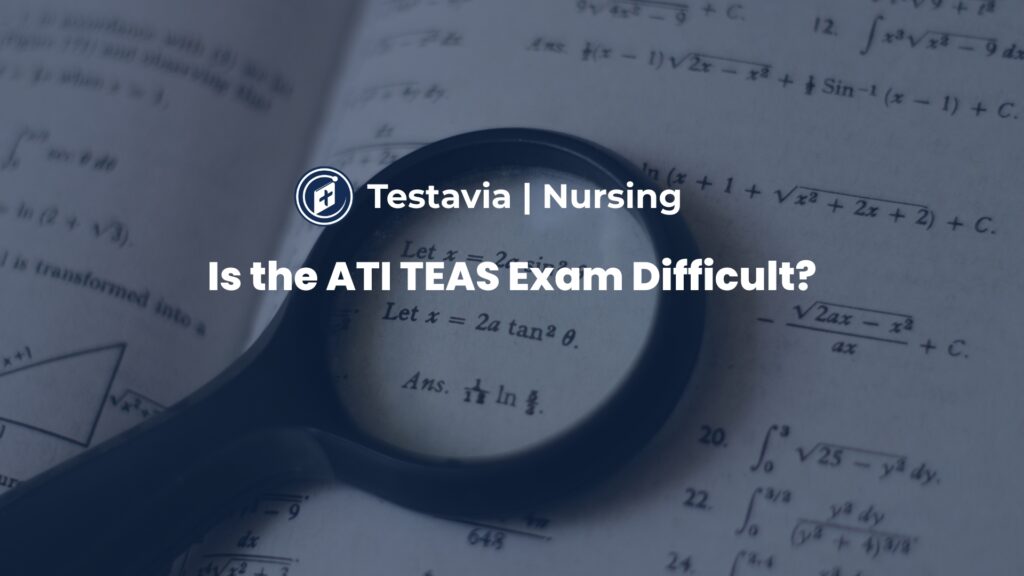
The ATI TEAS test is challenging but absolutely manageable with proper preparation. This exam designed to measure the core academic skills of reading, math, science, and English that you’ll need to succeed in nursing school. The test isn’t meant to trick you; its difficulty largely depends on how well you understand the content areas and how effectively you study.
To make it easier, first understand what the TEAS test covers and how it’s organized. The guide that follows will take you through everything, from the difficulty and time of the exam to the place where one can sit for the test, right down to how to effectively get ready. Additionally, we have crafted a proper ATI TEAS guide, head over to see more on how you can ace your TEAS exam.
Get to Understand why the ATI TEAS Test Difficult
The difficulty of the TEAS test is subjective and often depends on your academic background and how recently you’ve studied the subjects covered. This exam is usually administered by ATI Testing, is designed to be challenging. It evaluates your skills in four core areas: Reading, Mathematics, Science, and English and Language Usage.
- Reading: This section is meant to assess your ability to understand and interpret written passages, charts, and graphs.
- Mathematics: You’ll face questions on algebra, measurement, and data interpretation. For many topics like the ATI TEAS 6 math can feel tough if they haven’t practised them recently.
- Science: I often consider Science to be the most challenging section, covering human anatomy and physiology, life and physical sciences, and scientific reasoning.
- English and Language Usage: This part tests your knowledge of grammar, punctuation, sentence structure, and spelling. The ATI TEAS English questions require a strong command of standard English conventions.
While the content itself is based on high school-level knowledge I should let you know that the pressure of a timed exam and the breadth of topics can make it feel not easy. Success often comes down to dedicated preparation. Many students find that using an ATI TEAS practice test is the most effective way to gauge their readiness and identify areas that need improvement.
How long does the TEAS Test take?
The entire TEAS test is allotted 209 minutes, or just under three and a half hours, for 170 questions. However, only 150 of those questions are scored; the other 20 are unscored pretest items used for future test development. The time is broken down into four separately timed sections:
- Reading: 64 minutes for 53 questions
- Mathematics: 54 minutes for 36 questions
- Science: 63 minutes for 53 questions
- English and Language Usage: 28 minutes for 28 questions
This structure means you must manage your time effectively within each section. You cannot use leftover time from one section in another because this strict timing is another reason why practice is so important. Taking a full-length ATI TEAS practice test helps you get a feel for the pacing required to complete each section confidently.
Where can I take the TEAS Test?
You have several options for taking the TEAS test, offering flexibility to fit your location and schedule. ATI Testing provides two primary methods for taking the exam.
- At a Testing Centre: Many colleges, universities, and dedicated testing centres (like PSI) administer the TEAS test in person. This is a traditional, proctored environment where you’ll take the exam on a computer at the facility. You can find a list of participating institutions on the official ATI website.
- Online, Proctored by an Institution: Some schools offer the TEAS exam remotely, with proctoring provided by their own staff. This means you take the test from home while being monitored via webcam by a representative from the school to which you’re applying.
- Online, Proctored by ATI: ATI also offers remote proctoring. You can take the test at home, and a proctor from ATI will monitor you through your computer’s webcam and microphone to ensure test integrity.
Before registering, always check the specific requirements of the nursing programs you are applying to. Some schools may require you to take the test through their particular institution, while others may accept scores from any testing location.
How to prepare for the TEAS?
Preparation is the key to achieving a high score on this crucial nursing entrance exam. Simply reviewing old notes is often not enough. A structured study plan will help you cover all the necessary material and build your confidence.
First, start by understanding your baseline, then take a diagnostic-free practice test for each subject/section to see where you stand. This will highlight your strengths and weaknesses in the test, allowing you to focus your study time more effectively.
Many reputable sources including Testavia.com offer a ATI TEAS practice tests, which can provide valuable insight into the exam format and question types. Head over to Testavia.com and access free practice questions today.
Next, gather your study materials, since ATI offers official study guides, online practice assessments, and learning packages that are tailored to the current version of the test. These resources are invaluable because they are created by the same company that develops the exam. You’ll find detailed explanations for topics like ATI TEAS 6 math and know more about ATI TEAS English questions.
Create a study schedule and stick to it. Dedicate specific days and times to each of the four subjects. Don’t cram; consistent study sessions over several weeks are far more effective. For challenging subjects like Science or Math, consider forming a study group or seeking a tutor.
Finally, simulate test day conditions. As your test date approaches, take full-length, timed practice exams to prepare thoroughly. This will help you manage your time, reduce anxiety, and become more comfortable with the test’s pressure. By combining a solid study plan with consistent practice, you can walk into your TEAS test feeling prepared and ready to succeed.
Conclusion: Is the TEAS Exam Hard?
No matter how challenging the exam is, we help nursing school and pre-nursing students prepare adequately by providing them with reliable resources which include:
- Complete Study Guides.
- Practice Questions.
- Revision and study Tips.
- Wide range of revision material.
Sign up for your free TEAS Prep journey today and unlock hundreds of practice questions. Remember practice makes perfect!


I like how you broke down the exam into the four core sections—it really highlights that difficulty is relative depending on someone’s strengths. I’ve noticed that many students underestimate the Reading section, but those questions about interpreting charts and graphs can trip people up just as much as Science or Math. Building a prep plan that balances all areas instead of focusing only on the ‘hardest’ section seems like the smarter approach.